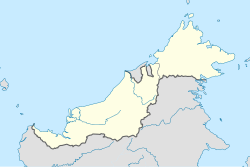Pakan | |
|---|---|
Town and district capital | |
| Other transcription(s) | |
| • Chinese | 巴干 |
 Replica of Buah Pakan at Pakan town | |
| Coordinates: 1°52′00″N111°41′00″E / 1.86667°N 111.68333°E | |
| Country | |
| State | |
| Division | Sarikei |
| District | Pakan |
| Government | |
| • District Officer | En. Seroji Bin Ludin (2017-Now) |
| Area | |
• Total | 924.6 km2 (357.0 sq mi) |
| Population (2020 [2] ) | |
• Total | 15,462 |
| • Density | 16/km2 (40/sq mi) |
| Time zone | UTC+08:00 (MST) |
| Postal code | 96xxx |
| Website | www |
Pakan is a small town in Pakan District, Sarikei Division, Sarawak, Malaysia. The district population estimates (as of the 2017 census) was 17,600. [3]
Contents
- Etymology
- History
- Government
- Geography
- Longhouses
- Climate
- Demographics
- Ethnicity
- Places of worship
- Economy
- Transport
- Local Bus
- Alternate road
- Other utilities
- Education
- Culture and leisure
- Cultural
- Historical
- Leisure and conservation areas
- Notes
- External links
- References
Most of its inhabitants are ethnic Iban people (95%+) and a few minority Chinese usually concentrated in its town area. A small minority of Malay work in a government sector, such as teachers, nurses, district officers, and police.[ citation needed ]








